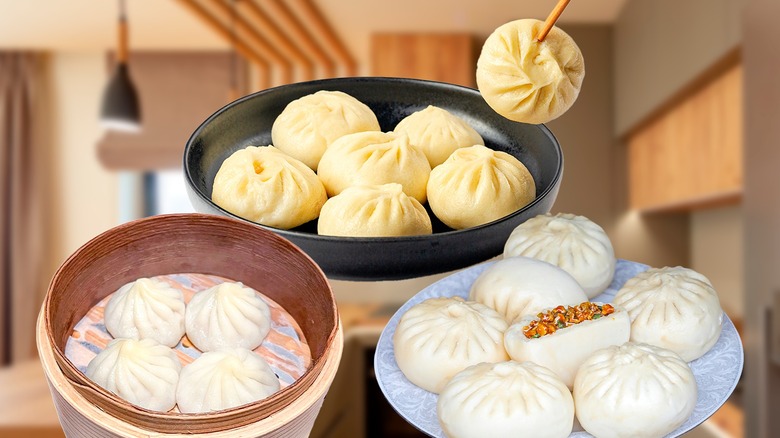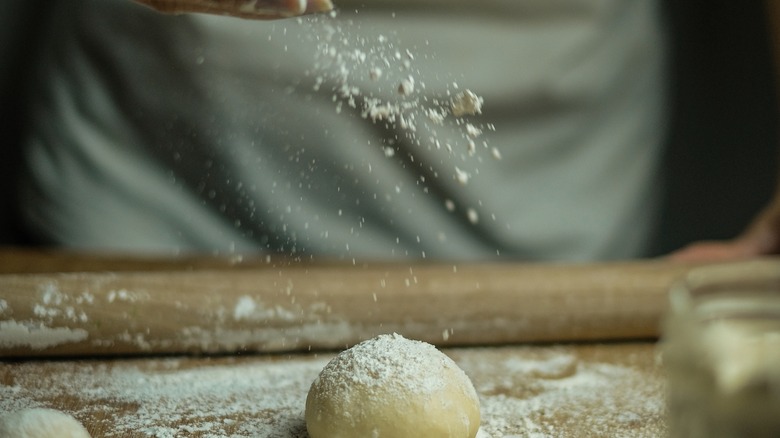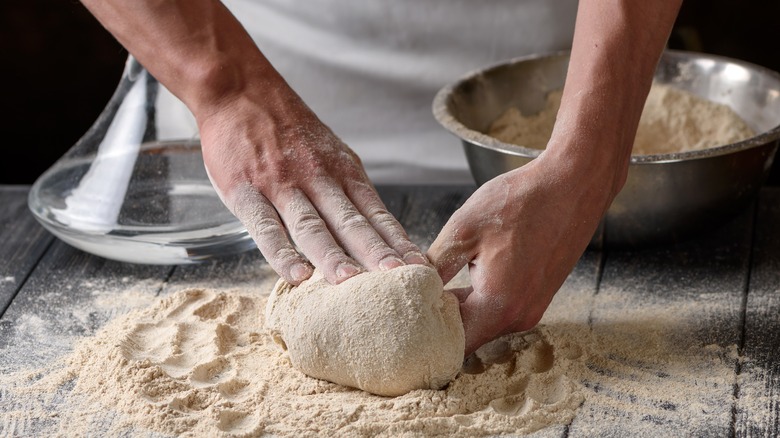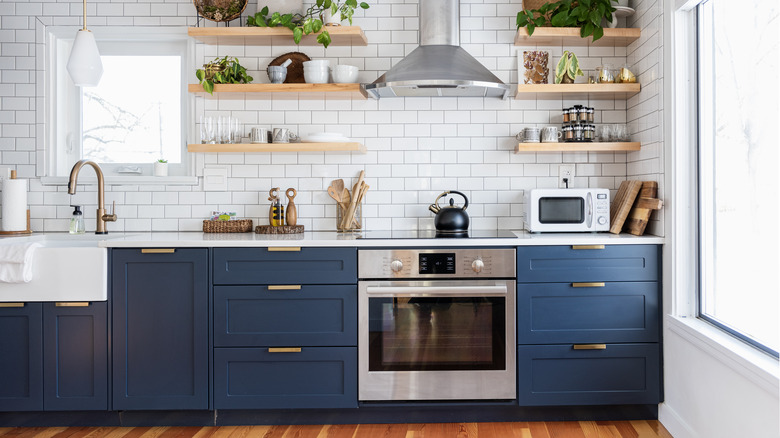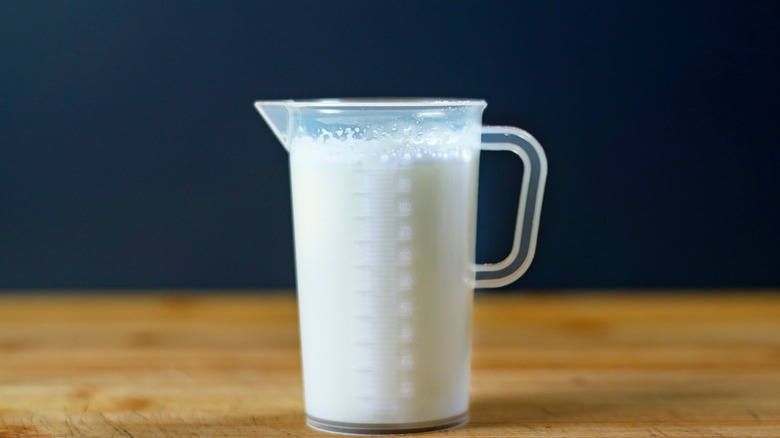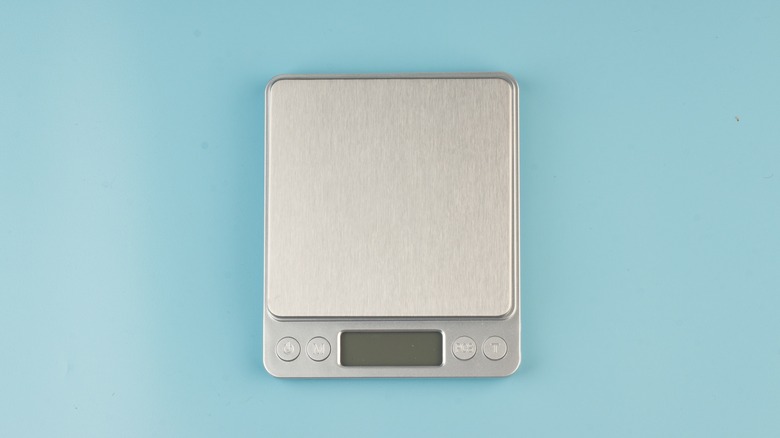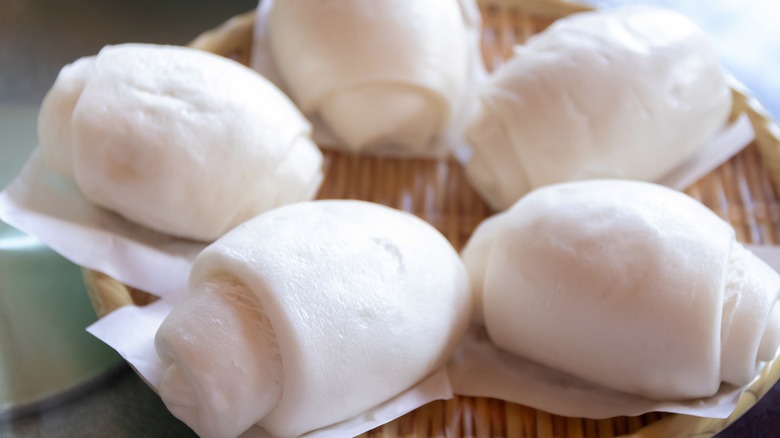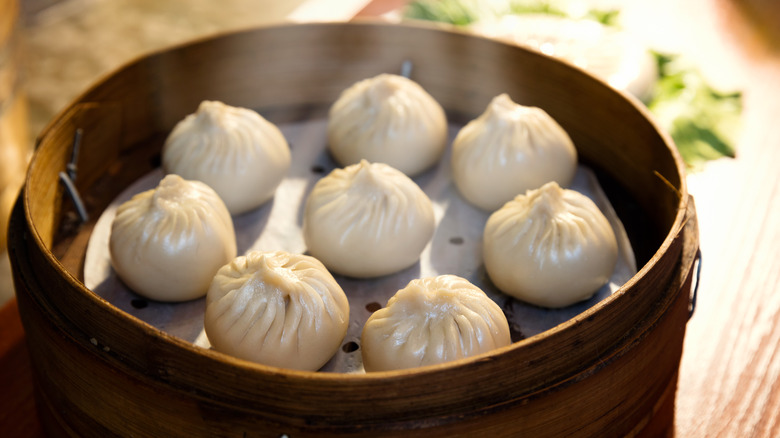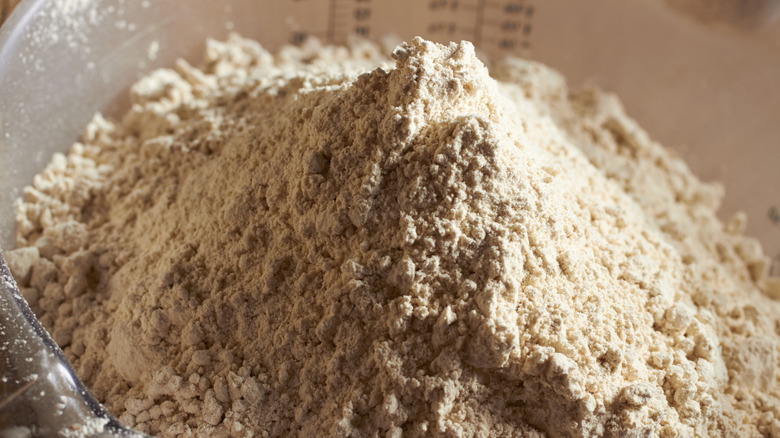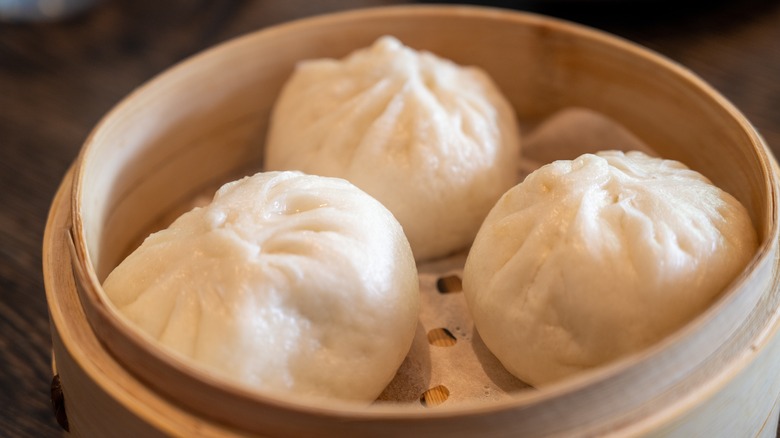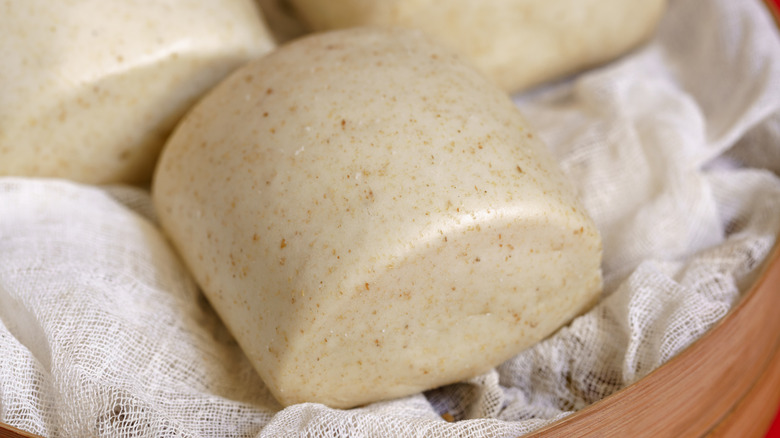12 Tips For The Best Homemade Bao, From A Cookbook Author
We may receive a commission on purchases made from links.
Bao are one of those foods that seemingly taste exactly like what they look like. These ethereally fluffy and bouncy buns are often found in Asian cuisine, including in countries like Taiwan and China. You'll see them wrapped around fillings, which can be sweet or savory, like dumplings, or they can be gently folded over like a leaf and stuffed with ingredients like pork, kimchi, and fresh veggies.
For Clarice Lam, author of "Breaking Bao," and many other eaters, bao are more than just a means of sustenance. "A bao is already a bun, but most people don't know that 'bao' translates to much more than that," she writes in her book. "In Chinese, the most common definition is a steamed bun, but it can also refer to a dumpling, a treasure, the act of wrapping something, or bread in general."
While you can purchase frozen bao from your local Asian market (or online), or stick to ordering them at a local restaurant, you could also try your hand at making this bread at home. We had an opportunity to speak to Lam about bao. She shared some of her best tips for mastering this tricky recipe at home and some important things to keep in mind when you're baking bao from scratch.
Use different types of flour to achieve your desired end result
Any bread baker will tell you that selecting your flour and being knowledgeable about its properties is the key to learning how to bake a proper batch of bread, whether it's focaccia, sourdough, or, in this case, bao.
Cookbook author Clarice Lam shares that the type of flour that you should select for your recipe varies based on what kind of bao you're making. For example, she recommends using all-purpose or bread flour for baked buns, and sticking to a cake flour for steamed buns. The main difference between these types of flour is the gluten content in them and how they're processed. Cake flour is ground finer than traditional flour and doesn't have as much gluten. As its name suggests, this type of flour is popular for cakes because it gives you that soft crumb — which is exactly what you want in your bao. Meanwhile, the baked bao can stand up to the coarseness and gluten in all-purpose flour, as well as bread flour (which has an even higher gluten content).
Dense and cracked dough may be a sign of overmixing
A baker should always be wary of how much they're manipulating and moving the dough. This is because once you combine water with your dough, any physical manipulation will strengthen the gluten bonds and structure. While you need to knead dough somewhat to give it structure, too much movement and kneading will alter the structure too much. "If the dough is overmixed, it will feel dense and tight and may crack or tear," Clarice Lam says.
In her recipe for basic mantou dough, Lam calls for kneading the dough for about 10 minutes using a stand mixer with a dough hook attachment. In her cookbook, she notes that the dough should look "very smooth" — which means there should be no dry or wet pockets. Knowing when to lay off the mixing can prevent you from having to toss your dough into the trash. Lam explains that there is no way to fix an overworked dough; she recommends tossing it and starting over if your dough starts to look too tight.
Don't neglect the resting process
Not many people can admit to being patient bakers — and that especially rings true when a recipe calls for you to rest your dough for a period of time. But, this resting stage is very, very important when it comes to the overall structure and consistency of your bao dough.
Clarice Lam explains that the resting process of all doughs, including bao, "... allows [it] to rest, build gluten strength, create more gas, and develop flavor through fermentation." Her mantou dough calls for an hour proof before the dough needs to be punched down, filled, and then rested again for another 45 minutes.
Lam shares that the process of making mantou, which is typically steamed, requires you to have some keen insight into how much you should expect the dough to rise. She explains that unlike other doughs, you shouldn't expect mantou to double in size during the resting process like you would with other types of dough. "It will only increase by about 50% before you need to punch it down and shape," she says.
If you're baking at high altitudes, you may need to alter your bao recipe
If you live high up in the mountains, you'll likely already know the struggles of cooking and baking at high altitudes. The long and short of it is that you may need to adjust your ingredient ratios and baking and proofing times to accommodate for a change in air pressure and ambient humidity. Bread is known to proof faster at high altitudes because the air is thinner, while many folks have reported having to add more moisture to their bakes to account for the drier conditions.
Clarice Lam shares that bao are not exempt from this altitude-based recipe modification. "Generally, when baking at higher altitudes, you will need to add more moisture, use a higher protein flour, reduce the bake time, and use a higher temperature in your oven," she explains. While it might require a little bit of work to adjust your recipe to fit the conditions you're working with, it will ensure that your buns come out perfectly plush and risen.
Using a dairy-free substitute in your bao is possible, but it may change its consistency
Clarice Lam's basic mantou recipe calls for whole milk. But, that doesn't mean you can't find ways to tweak it so that you can make dairy-free versions of classic bao.
Lam notes that the whole milk helps ensure that the bao stays fluffy and soft, so you should expect to see some textural changes if you substitute it out with a plant milk alternative. She also notes that you may see some oil spots crop up in your dough when you make this swap.
"If you do need to substitute, I would use soy milk to achieve the most similar outcome," she suggests. This is likely because soy milk has a high protein content that is more similar to milk than other substitutes. You'll also want to be sure you select unsweetened soy milk so that you don't alter the flavor of your bao or the yeast activity too much.
Scales make bao easy to portion
One option for portioning your bao is to eyeball it. A little here, a little there — it will all come out right in the end, right?
Well, not exactly. It's important to evenly portion your bao out when you are in the shaping step. If you have a few bao that are larger than the others, they will take longer to bake, steam, or however else you decide to cook them. This means you may have some bao that are overcooked, and others that are undercooked.
Clarice Lam admits that she always uses a scale for her dough, and notes that folks should pay attention to the number of bao that each recipe makes. This will allow you to easily divide the total weight of the dough by the number you want to make, which will give you some number for what you should be looking for on the scale.
Mantou buns will typically be drier than other steamed buns
It can be difficult to bake something if you're going in blind with no understanding of what you should be looking for in the finished bake. For example, when it comes to making mantou, the dough should be glossy, yet not sticky. "I have never experienced a sticky dough for steaming bao. If the dough is sticky, you are not using a good recipe," says Clarice Lam.
Lam goes on to explain that mantou dough should actually be drier than the type of bao dough that you'd bake because the steam will add more moisture to the dough, which will not happen with a baked bun. She explains that the dough should feel "smooth and marshmallowy" under your fingers; this might be a texture that you have to play with a few times in order to get right.
Bao can be baked or steamed
There are two common methods used for preparing bao: steaming and baking. Besides the difference in cooking methods, Lam explains that there is also a difference in the type of dough that is used. Baked bao typically utilizes a milk bread dough, while the steamed mantou buns will use a simple yeast-raised dough.
In her cookbook, Clarice Lam explains that Japanese-style milk bread is a popular find in Asian bakeries. The base of it is made from tangzhong, a combination of flour, milk, and water cooked down into a paste on the stovetop. After the tanzhong has been adequately cooled, the paste can be added to the rest of the bread ingredients. The result is a dough with a feathery consistency that lasts longer on the counter than other varieties of bread. Milk bread can be turned into baked bao, like Lam uses in her cookbook, or it can be added to other recipes, such as her gochujang pizza rolls.
Try experimenting with different flours and flavors in your recipe
You can experiment with more than just pastry flour, all-purpose flour, and bread flour in your bao recipe. Clarice Lam recommends that folks try other types of flour or flavor enhancers to alter the flavor of their recipe. She explains that you can add everything from matcha powder to freeze-dried fruits to alter the color and consistency of your dough.
"Breaking Bao" also includes recipes that utilize more unconventional flours, too. One recipe that will really give you pause is the one for buckwheat bao with a black sesame filling. It combines buckwheat flour, which has a nuttier and bolder profile, with a more neutral-tasting cake flour to give the bao a traditional consistency with a burst of flavor. The nuttiness of the black sesame and roasted peanut filling is the perfect contrast to the flour. Lam also has a recipe for chocolate bao in her book, which is stuffed with a tantalizing chestnut filling.
There has to be some method-to-your-madness when it comes to adding ingredients to your bao recipe, though. "Just keep in mind adding powders or changing the flour will throw off the wet ingredients ratio, so you may need to adjust accordingly," she says.
Avoid very wet fillings
Although there are seemingly endless options for bao fillings, there are also several fillings that you should avoid using in your bao due to their moisture content. "I wouldn't fill bao with anything super liquidy; it will be so annoying to even shape the bao, and it won't hold its structure," Clarice Lam shares.
In "Breaking Bao," Lam gets creative with her fillings, but always cooks down or removes some of the moisture in the filling so that she gets the perfect consistency in every bite. Her recipe for sweet corn custard bao, for example, uses turmeric and matcha to color the dough before it's shaped into corn cobs and filled with a sweetened corn custard filling. If you're trying this recipe for yourself, you'll want to be sure to cook down and thicken the custard perfectly so that it doesn't soak into the fragile bao encasing it.
Leftover bao can be stored and enjoyed later
Making a batch of bao can feel like an act of love, so it's understandable that you would want to make them ahead of time and store them for when the mood strikes. Luckily, Clarice Lam shares that this is indeed possible, but the method you use for storing and reheating them will depend on what type of bao you're making.
She shares that steamed bao can frozen or refrigerated in an airtight container, like a freezer bag, and re-steamed to be brought back up to temperature and softened. If you're baking baked bao, your fillings may dictate which type of storage method is best. For example, if you are working with fillings that won't spoil, you don't have to worry about storing your baked bao in the fridge or freezer, which could potentially alter their texture. But, if you're working with perishable fillings, you can keep them in the fridge and reheat them in the microwave or toaster oven when you get hungry.
Once you master bao, try mantou donuts
"Baking Bao" features a range of recipes beyond just buns. In fact, once you master the basic recipe, you can start exploring different preparations, including Clarice Lam's inventive recipe for mantou donuts.
The key difference that sets these donuts apart from regular ones, besides a slightly different dough base, is the fact that the bao must be steamed before they can be fried. This will give the dough the moisture and pliability it needs to be a successful donut base. Once the donuts have been steamed for about 10 minutes, they can easily be plopped into the hot oil before being tossed in a sweetened condensed milk glaze. The result is a pliable donut, best served warm. Another perk to this recipe is that you can make the bao ahead of time and store them in the fridge for up to three days or freeze them for up to three months. As Lam notes in her book, it's important to bring the buns up to room temperature before plunging them into the hot oil.
